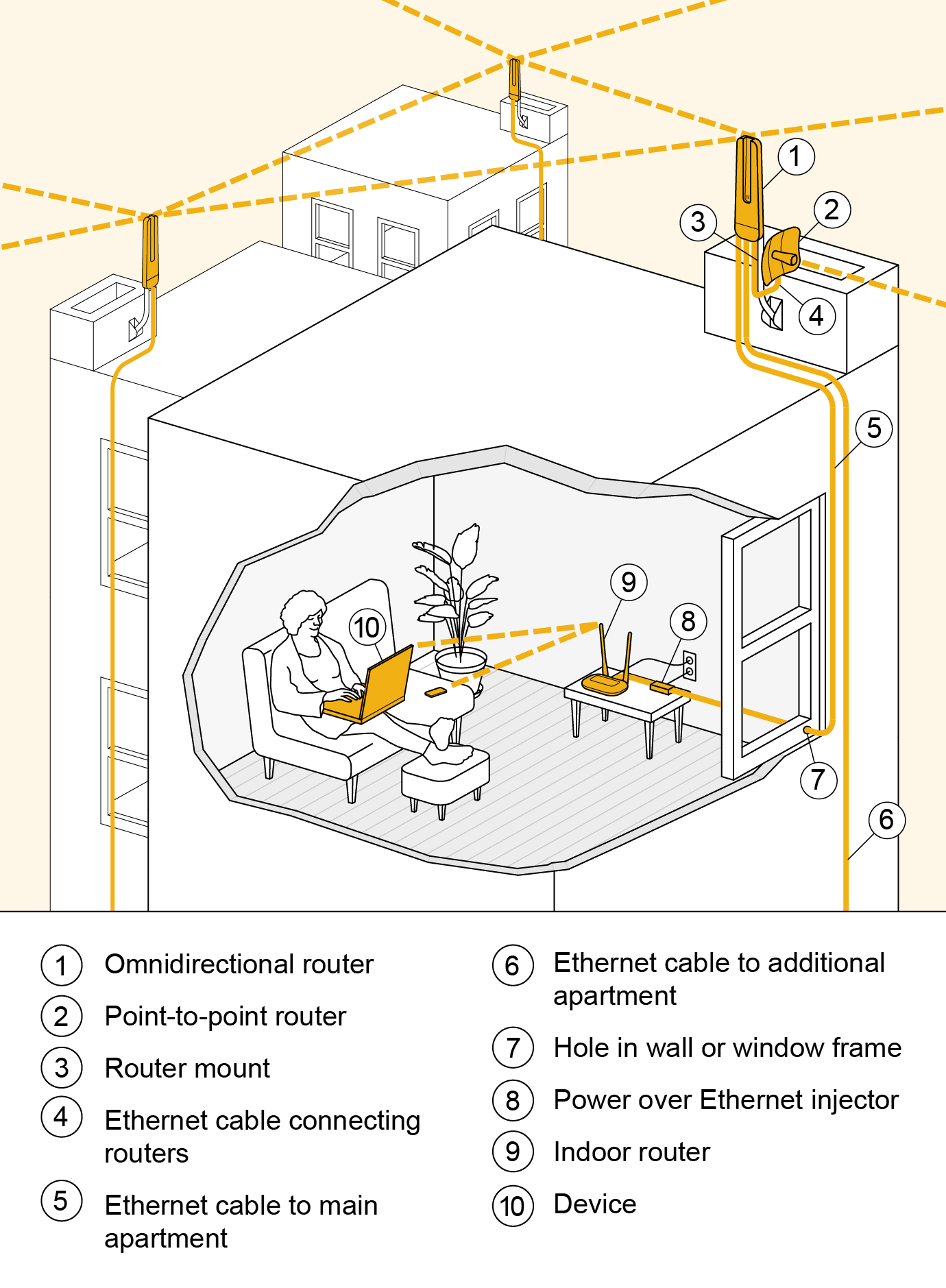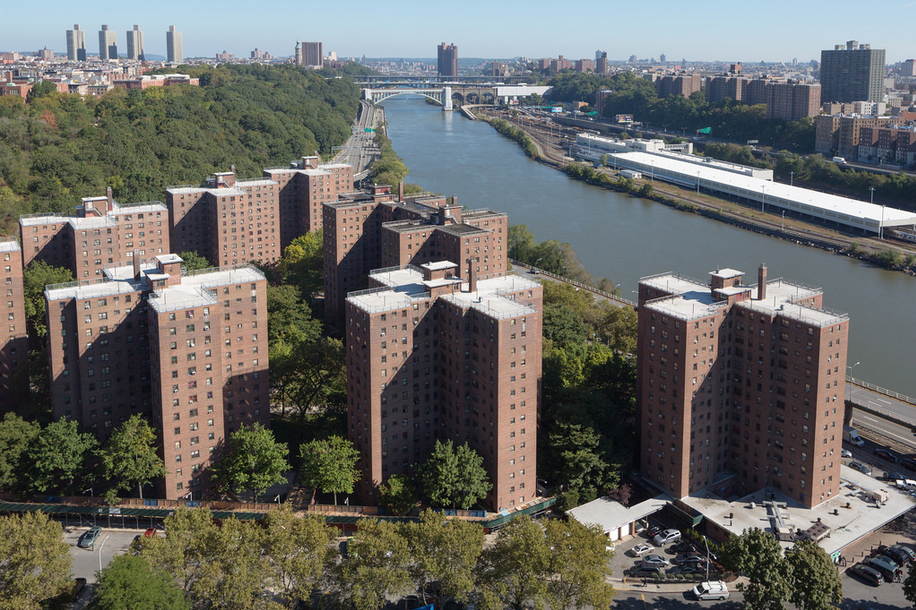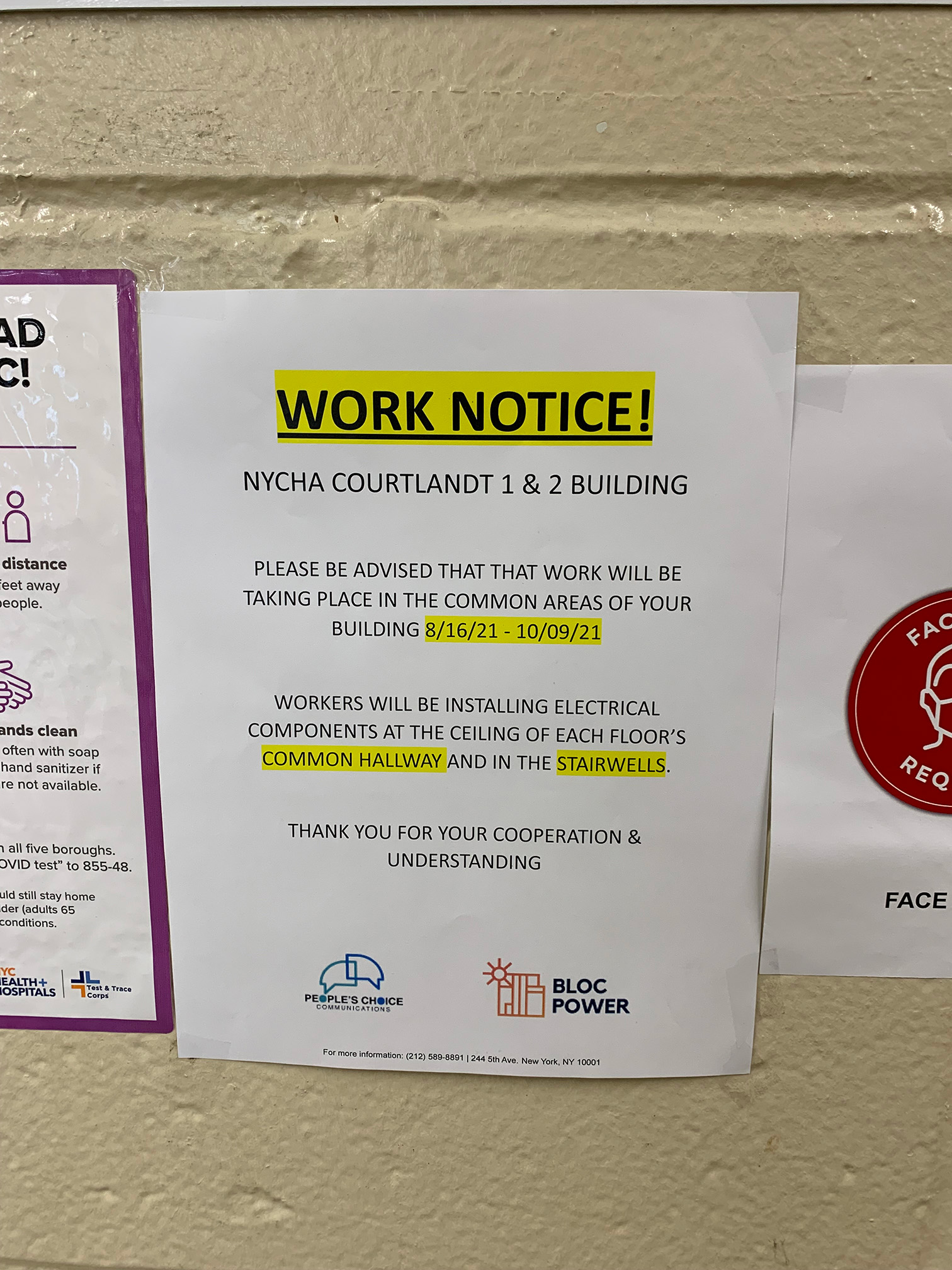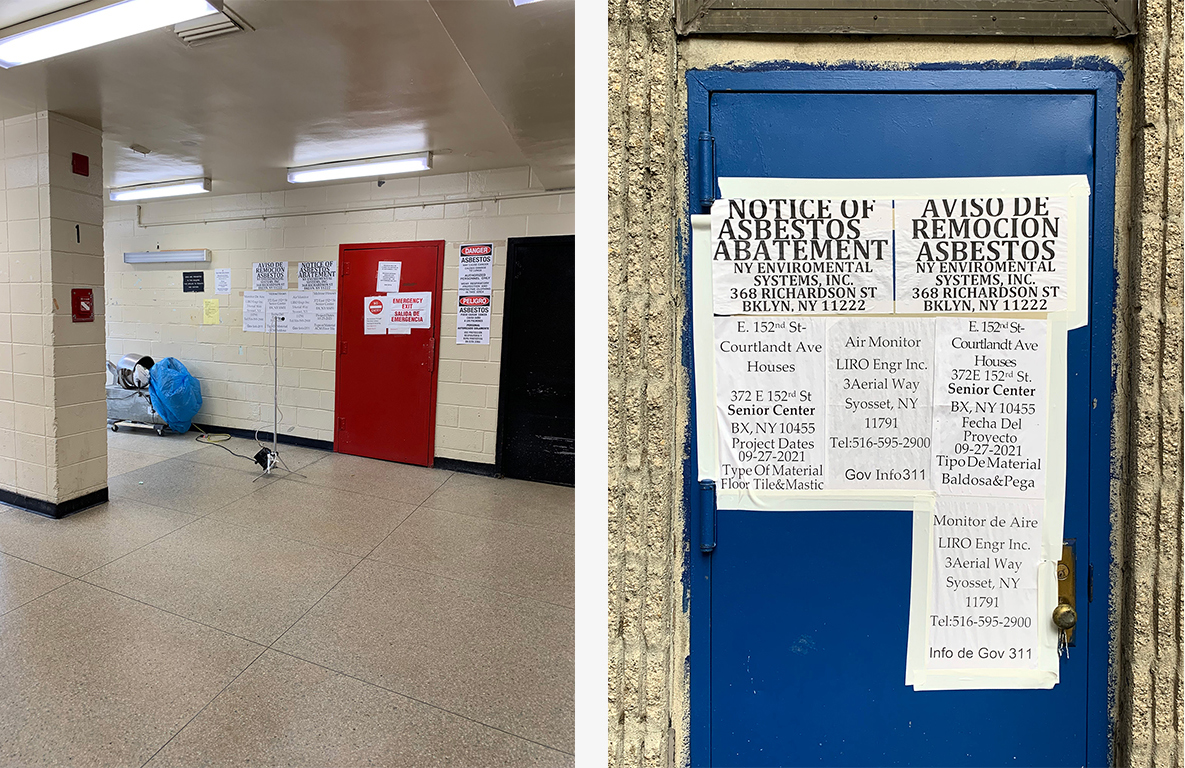A signal shakes New York City’s air with a familiar frequency: accountability. In New York, as elsewhere, signs of inequality have become more pronounced during the COVID-19 pandemic—the delirious ultrathin skyscrapers rising throughout the city are perhaps its most visible evidence, pointed symbols of enormous wealth peering down at people below.1 Amid this agitated atmosphere, New Yorkers have called for accountability from their political and economic leaders. But what should these calls demand? Should they look to the imagined future of the city? Should they instead locate responsibility for the existing decisions that fashion our unequal present? Ascending into New York City’s fraught airspace, unexpected partners are formulating one answer to this question. The problem of internet access in New York has generated unfamiliar collaborations and new flashpoints, and this problem is at the core of City Hall’s attempts to address inequality.
In a press release from October 2021, titled “New York to Close Digital Divide for 1.6 Million Residents, Advance Racial Equity,” the office of former mayor Bill de Blasio announced a planned legacy: to expand broadband internet access to all New York households.2 The release quotes an array of philanthropists, CEOs, and New York political figures, though its general tone can be summarized in comments by Ford Foundation president Darren Walker: “The last 20 months have made clear what we’ve long known—fast, reliable, and affordable internet is not a luxury, it’s an essential utility.”3 This internet-as-utility rhetoric is in vogue, and the City of New York is its champion. Politicians appear to have decided that “bridging the digital divide” will resolve a range of inequalities that the COVID-19 pandemic has laid bare.4
The digital divide has been a topic of concern for economic and political leaders for decades. It is not only a misnomer but a potentially dangerous fixation.5 It lies comfortably in a political ethos that prescribes more technology as the solution to historically rooted social imbalances. In light of the pandemic, this techno-optimistic rhetoric has reached new heights through the conflation of broadband internet with more traditional utilities like water and electricity. For instance, the Biden administration’s federal infrastructure bill planned to allocate $65 billion to broadband internet expansion, with private players already lining up to capitalize on those funds.6 All this has unfolded while more conventional utility access—things like heat and running water—remains less-than-assured for many people living in New York and elsewhere.7 Solving a particular technological access problem, in short, does not solve the distributional roots of inequality.
Yet, internet access creeps toward being the datum for full political and economic participation. Recent government initiatives, punctuated with uncanny neologisms like digital redlining and internet masterplan, use spatial metaphors to smooth over the large-scale digitization of the economy.8 In doing so, they naturalize the internet’s position in a society aware of its own inequities yet unable to resolve them. De Blasio’s last digital divide initiative, for example, presumes to “Advance Racial Equity” using an exceptional mode and site of broadband expansion.9
This fixation on technological access has intersected with the more conventional, physical supports of the city in surprising ways. An iconic and contentious architectural type in New York has become the pulpit for tech evangelists: the vertical housing block. While the management of New York City Housing Authority (NYCHA) properties has typically been overlooked by city leaders, these buildings are home to residents who can speak clearly to the shape of political accountability in the city (or lack thereof). This is evident, more broadly, in the longer history of public housing buildings in New York, where it has served less as a bona fide solution to poverty than as a way to externalize many of the city’s poorest citizens.10 Since the “white flight” of the 1960s, towers have been cast as verticalized hinterlands that housed populations considered irredeemable—often people of color, immigrants, the elderly, and the poor. In these conspicuous structures, residents are subject to new experiments in infrastructure and surveillance, ones enabled by cutting-edge technologies.11
NYCHA’s most recognizable architectural symbol is referred to as the “tower-in-the-park.” The history of this type, rooted in a prewar European Modernism, is well documented in, among other places, Richard Plunz’s History of Housing in New York City. Plunz describes a postwar New York where this type of building satisfied the aims of corporate architects, liberal establishment figures like Nelson Rockefeller, and a bureaucratic milieu figureheaded by Robert Moses.12 There were, on the other hand, people whom this building type did not satisfy: namely, large numbers of their residents. In studies as early as 1969, a tower-in-the-park-type NYCHA building experienced 40 percent more maintenance requests than an older neighboring low-rise NYCHA building of a similar tenant composition.13 Cheap construction methods coupled with sheer vertical scale and density led to a greater frequency of utility outages, which were often left systemically unaddressed. Of course, this kind of tower-in-the-park architecture has been subject to much debate, inside and outside its walls, for decades.14
Today, these most visible remnants of New York’s midcentury social housing intersect with new tech programs full of promises. Beginning in 2021, technicians contracted by Mayor de Blasio’s government have worked to install rooftop hardware on 13 NYCHA buildings to enable residents to access the internet through a relatively new form of broadband network known as mesh Wi-Fi.15 I first discovered mesh internet in 2020 when commiserating with my neighbors over Optimum’s unreliable service in my old apartment building in Crown Heights, Brooklyn. I had just started my first year at Columbia University, online, and was frustrated by constant, sometimes debilitating connection disruptions. In the depths of the pandemic, one tenant (an acclaimed visual artist, I later discovered) had organized the installation of a mesh router on our building’s roof. Gossip traveled quickly in those indoor days, and, before long, my roommates and I realized we could enjoy a free, high-speed, and more reliable service than what was offered by private Internet Service Providers (ISPs) in our area. Before we even found a cable long enough to span the distance from the roof router to our apartment, we had canceled our Optimum service.

Mesh internet works through nodes and supernodes. Wired supernode signals are sent to a constellation of smaller wireless nodes, each new one making those around it stronger. What makes mesh Wi-Fi exceptional is that the decentralized, versatile framework of its technology is often mirrored in its organizers, especially its earliest evangelists.16 The network to which our building now belonged, NYC Mesh, is a free service funded by donations and operated by volunteers.17 Started in 2012, NYC Mesh has an air of vigilantism to its operations. Its volunteers seem proud to deliver a service that neither internet companies nor city government were capable of, especially since the onset of the pandemic. That pride grew further when a NYCHA resident contacted NYC Mesh wanting to install a node on the roof of their building. Through this minor act, a government partnership began that holds the potential to transform lives across the city.18

The exceptional formal qualities of the tower-in-the-park afforded NYC Mesh volunteers a kind of beacon. Height and ample sightlines make these buildings perfect candidates for nodes in a mesh network.19 As NYC Mesh install leader Rob Johnson says, “We’ve been making the case for a while that the type of service we build is uniquely beneficial to public housing the way it was constructed in New York—these tall buildings amidst fairly short buildings.”20 This tallness, long considered a liability in maintaining NYCHA’s utilities, has suddenly become an asset for mesh internet technology, the quintessential “utility” in today’s political rhetoric. These megastructural projects, produced through centralized authority, have now been enlisted to mount a decentralized form of infrastructure. This infrastructure has since started to bring traffic.

One person who saw these beacons clearly was BlocPower CEO Donnel Baird, who has long worked to improve building efficiency in New York’s poorest neighborhoods.21 Nearly 90 percent of NYCHA residents filed a heat and hot water complaint in 2019, over 130,000 complaints in total.22 Maintenance issues in these buildings are so systemic that the US Attorney for the Southern District of New York recently sued NYCHA, claiming that building maintenance was severely neglected and that their reports to federal agencies were intentionally misleading. As a result, a federal monitor was appointed to oversee the agency.23 In response to these conditions, Baird’s BlocPower has proposed retrofitting NYCHA’s mechanical systems with data-collecting, analytic-driven “smart” technologies.24 Baird imagines that these sensors and networks will help residents hold the Housing Authority accountable when maintenance is required. These new systems need broadband internet (something virtually all NYCHA lots lack) and the popularization of mesh Wi-Fi arrived at the perfect time for BlocPower’s imagined remote sensor ecosystem.
Mesh networks, often referred to as “community internet,” span a diverse set of interest groups, properties, and programmed spaces and thus require a certain level of grassroots engagement. This kind of community participation can puzzle startups and tech companies promising quick, product-based solutions. When Baird’s BlocPower won a contract with New York City to work on the NYCHA-owned Courtlandt Houses in the Melrose area of the Bronx, they subcontracted with a mesh Wi-Fi service provider. This service, People’s Choice Communications, was formed by members of the International Brotherhood of Electrical Workers Local No. 3, a union currently engaged in the longest strike in American history against communications giant Charter Spectrum.25 Formerly builders of Spectrum’s physical internet infrastructure, the member-owners of this independent ISP provide internet in a part of New York where close to 40 percent of households lack broadband access (in some areas, that number may be closer to 50 percent).26 For their customers and workers alike, New York’s mainstream ISPs have considerable lag. The residents of buildings like the Courtlandt Houses constantly deal with deteriorated and unmaintainable utility systems. Is Baird’s quasi-infrastructural Internet of Things the solution, or just another fritzy utility?27 Either way, the concept has already helped Baird win city contracts at five NYCHA sites, the Courtlandt Houses being the first.28

In late 2021, during my second year at Columbia, I received a studio brief for a housing complex on the site of the Courtlandt Houses. On one of several visits to the building, I found People’s Choice volunteers parked in a sprinter van outside. Workers were running cables down from a rooftop node to floors inside the building. Though the installations suffered some delays (an expected completion date posted in the lobby had passed by several weeks), they generally occurred swiftly, representing the most ambitious building-wide project the complex had seen in decades. However, while progress was made on the roof, the senior center and kitchen on the ground floor had been closed for months awaiting asbestos removal. A security guard I spoke with lamented the slow process, predicting it would be many more months before the hazardous material would be removed and the community facilities could reopen.29 Internet service, which had been installed with the hope of making building repairs easier, was, at least for now, powerless to move the bureaucratic gears behind asbestos abatement.
Setting aside the viability of Baird’s ideas, what is the point of residents having Wi-Fi if they shouldn’t even be breathing the air it travels through? As Shannon Mattern writes, “Smart technologies often furnish convenient stopgap solutions: they provide a quick, and often lucrative, targeted fix that absolves leaders of the responsibility to investigate and resolve the root causes for health and racial injustices and systemic breakdowns.”30 When New Yorkers and their politicians focus so high up, issues much closer to the ground can go unresolved. What gets overlooked and unresolved when New Yorkers and their politicians only look up?

Another effect of BlocPower’s proposed plethora of sensors is that it promises to place NYCHA residents under an unrelenting regime of surveillance. In this imagined world, sensors don’t just provide maintenance information to property managers but also offer a concerning opportunity for less empathetic actors—whether New York’s police or its real estate developers—to gain private advantage from public goods. This arrangement and the tensions that come with it have become more palpable since New York inaugurated Eric Adams as its mayor in January 2022. Adams brings a distinct attitude toward technology and accountability to bear on the built environment. A former police officer, he is comfortable with a framework of reform in which technological intervention supplants accountability in either maintenance on the ground or progressive policy change. While tech need not be a foil for accountability, if it is deployed in a manner inattentive of its social determinants and consequences, even well-meaning solutions can quickly become agents of neglect, or worse. As Mattern points out, technological fixes often shift the conversation away from political accountability and deliver results far from the vision promised.
Inspired in part by Baird’s proposal for a sensor array that monitors maintenance, Adams’s provisional mayoral policy calls for the implementation of NYCHAstat, a nod to the New York Police Department’s (NYPD) infamous COMPstat program.31 New Yorkers may know COMPstat as the initiative that used statistics on crime such as frequency and location to catch and prosecute criminals in the 1990s.32 This program dramatically reduced the number of crimes committed in the city, but because of its blindness to socially determined factors, it also set the groundwork for overtly racist policing measures like “stop-and-frisk.”33 Adams’s NYCHAstat proposal brazenly implies that public housing developments are corollaries of policing. The proposal involves residents’ regular use of new portals, apps, and QR codes that are more effective as surveillance than as the data-backed methods of municipal consolidation they claim to be.34 Bringing tracking apparatuses into these places risks collateral punishment: it is an open secret that many NYCHA units are overcrowded or home to otherwise unsanctioned residents, residents who often have nowhere else to turn for housing.35
New Yorkers should be skeptical of anyone who says that data, a massive and exponentially growing sector of the economy, is actually the raw stuff of accountability, or a solution to long-standing ills on its own. Baird, while not especially critical of big data, has so far been largely successful in uplifting inhabitants of the built environment and holding its makers accountable. His work runs counter to a long history of technological innovations and innovators that bolstered the status quo and its biases. For Baird, adaptive and incremental technological improvements are all that is available to the infrastructurally disenfranchised communities with whom he works. For the city, however, the alluring techno-fix, coupled literally and metaphorically with the airiness of political rhetoric, acts as a substitute for addressing more obstinate problems of inequality. While Baird may see these Wi-Fi networks as a novel air current, they appear to other organizations a lucrative trade wind.
The city has enthusiastically backed organizations like BlocPower in their stated mission to “franchise our way to universal broadband,” over the likes of the more grassroots NYC Mesh, whose approach is not as easily integrated into private ownership. BlocPower’s conventional corporate organization appeals more to city government than NYC Mesh’s vigilante swagger, even if BlocPower’s mode of engagement clashes with the inherently collective tech in question. NYC Mesh, whose ad hoc approach made successful partnerships possible, has received no leg up in recent contracts with the city. In the latest NYCHA initiative, they have been awarded fewer contracts to work on buildings than some private companies that have less experience with the mesh technology being implemented.36 The most glaring problem in NYCHA’s partnership with private mesh ISPs, including several startups, is that it sanctions these buildings as free-market testing grounds. This bias toward private actors now appears to be the prevailing air pattern: Adams also advocates selling NYCHA’s physical airspace to developers and eventually transferring entire NYCHA buildings to private management through his fast-tracking of the Permanent Affordability Commitment Together (PACT) program.37
What set of relations does this new structure imply? While privately managed NYCHA buildings are still relatively few in number, a recent Human Rights Watch report lays out a concerning picture of the new program.38 The report, titled “The Tenant Never Wins,” is a barometer for things to come. For instance, PACT buildings are not subject to the federal oversight monitor currently assigned to NYCHA.39 Can we trust financial behemoths to maintain public housing for the city’s most under-resourced communities? If accountability has historically been hard for tenants to pin down, it may now be entirely up in the air. Between funding structures and the technological faith of today’s city government, any accountability dictated by public housing residents over these new airwaves will likely be in spite of their origins, not because of them. Mesh Wi-Fi installation provides a signal carrying the means for accountability, yet to those with their feet on terra firma, it may just be virtue signaling. Accountability, in any form, must take root in the ground before it carries through the air.
-
Stefanie Stantcheva, “Inequalities in the Times of a Pandemic,” Harvard Center for Economic Policy Research, April 15, 2022, link. ↩
-
“New York City to Close Digital Divide for 1.6 Million Residents, Advance Racial Equity,” official website of the City of New York, Office of the Mayor, October 28, 2021, link. ↩
-
“New York City to Close Digital Divide for 1.6 Million Residents.” ↩
-
Stantcheva, “Inequalities in the Times of a Pandemic.” ↩
-
“Falling through the Net: Defining the Digital Divide: A Report on the Telecommunications and Information Technology Gap in America,” US Department of Commerce, National Telecommunications and Information Administration, 1995, link ↩
-
“Fact Sheet: Department of Commerce’s Use of Bipartisan Infrastructure Deal Funding to Help Close the Digital Divide,” US Department of Commerce Office of Public Affairs, November 10, 2021, link. ↩
-
Chris Sommerfelt, “NYCHA Blames Building Disrepair on COVID Rent Shortfalls, Angering NYC Council Members,” New York Daily News, March 8, 2022, link. ↩
-
“NYC Internet Executive Summary Master Plan,” Mayor’s Office of the Chief Technology Officer, January 2020, link. ↩
-
“New York City Announces Free and Low-Cost Broadband Access for 13 NYCHA Developments,” official website of the City of New York, Office of the Mayor, May 6, 2021, link. ↩
-
Peter Marcuse, “Mainstreaming Public Housing,” in New Directions in Urban Public Housing, ed. David Varady (New Brunswick, NJ: Center for Urban Policy Research Press, 1998). ↩
-
Richard Plunz, A History of Housing in New York City, (New York: Columbia University Press, 2016), 262. ↩
-
Plunz, A History of Housing in New York City, 260. ↩
-
Plunz, A History of Housing in New York City, 272. ↩
-
Plunz, A History of Housing in New York City, 280. ↩
-
“New York City Announces Free and Low-Cost Broadband Access for 13 NYCHA Developments.” ↩
-
Michael Del Castillo, “Meet the Mesh Messiah of the East Village,” New York Business Journal, October 5, 2015, link. ↩
-
Jessy Edwards, “Sick of Traditional Internet Providers, BK Neighbors Are Setting Up Their Own Wi-Fi with NYC Mesh,” Brooklyn Reader, May 10, 2021, link. ↩
-
Bliss Broyard, “ ‘Welcome to the Mesh, Brother’: Guerrilla Wi-Fi Comes to New York,” New York Times, July 16, 2021, link. ↩
-
Broyard, “‘Welcome to the Mesh, Brother.’” ↩
-
Emily Nonko, “How NYC Will Connect Millions of People to the Internet,” NextCity, November 9, 2021, link. ↩
-
Donnel Baird, “Testimony: Donnel Baird on Generating Equity and Deploying a Just and Clean Energy Future,” Before the House Energy and Commerce Committee and Subcommittee on Energy, April 20, 2021, link. ↩
-
“NYCHA Residents Have Filed Over 130,000 Heat and Hot Water Outage Complaints So Far This Heat Season,” Legal Aid Society, January 15, 2020, link. ↩
-
Jackson Gandour, “The Tenant Never Wins: Private Takeover of Public Housing Puts Rights at Risk in New York City,” Human Rights Watch, January 27, 2022, link. ↩
-
“How to Make Wi-Fi Affordable: A Mesh Technology Explainer,” BlocPower, Youtube, March 30, 2020, link. ↩
-
The “Internet of Things” is a group of objects with sensors, processing ability, software, and other technologies that connect and exchange data with other devices and systems over the internet. ↩
-
“BlocPower, Metro IAF and People’s Choice Narrow the Digital Divide with Innovative Multi-Stakeholder Cooperative Wi-Fi Installation Connecting 2,500 NYCHA Residents in the Bronx,” BlocPower, November 29, 2021, link. ↩
-
From an interview with an independently contracted security guard who wished to remain anonymous. Interview by author, Bronx, New York, October 13, 2021. ↩
-
Shannon Mattern, A City Is Not a Computer: Other Urban Intelligences (Princeton, NJ: Princeton University Press, 2021). ↩
-
Ethan Geringer-Sameth, “Can the Next Mayor Save NYCHA? Democratic Candidates Offer Varied Plans for City’s Crumbling Public Housing,” Gotham Gazette, June 8, 2021, link. ↩
-
Chris Smith, “The Controversial Crime-Fighting Program That Changed Big-City Policing Forever,” New York Magazine, March 3, 2018, link. ↩
-
“Stop-and-frisk” refers to a brief police stop of a suspect for whom the police have reasonable suspicion. In 2013, a federal judge deemed the policy unconstitutional. ↩
-
“Eric’s Housing Plan,” Eric Adams for Mayor, November 8, 2021, link. ↩
-
Jake Blumgart, “The Ghost Tenants of New York City,” Slate, March 3, 2016, link. ↩
-
“New York City Announces Free and Low-Cost Broadband Access for 13 NYCHA Developments.” ↩
-
“Eric’s Housing Plan.” ↩
-
Gandour, “The Tenant Never Wins.” ↩
-
Gandour, “The Tenant Never Wins.” ↩
Peter Walhout is currently a Master's of Architecture student at Columbia University's Graduate School of Architecture, Planning, and Preservation. He holds a B.A. in Architecture from the University of San Diego.

